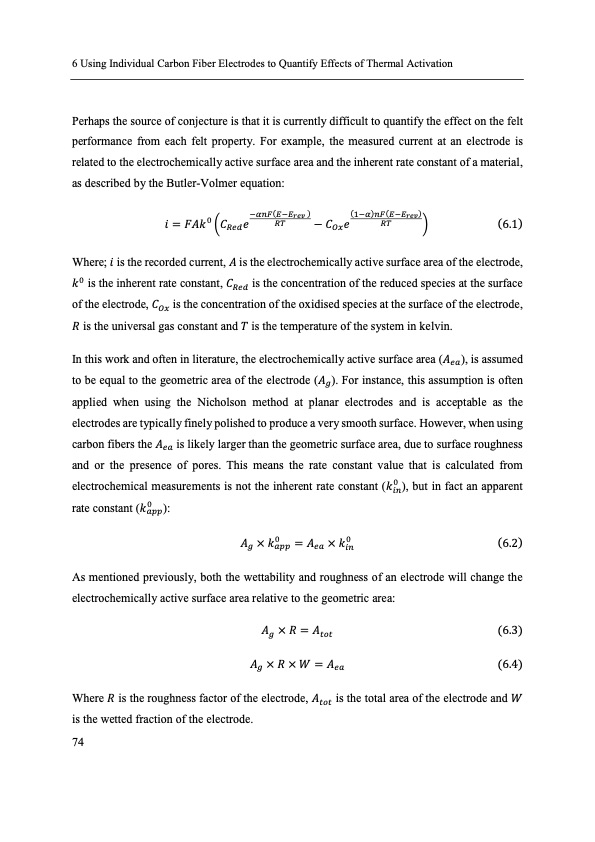
PDF Publication Title:
Text from PDF Page: 086
6 Using Individual Carbon Fiber Electrodes to Quantify Effects of Thermal Activation Perhaps the source of conjecture is that it is currently difficult to quantify the effect on the felt performance from each felt property. For example, the measured current at an electrode is related to the electrochemically active surface area and the inherent rate constant of a material, as described by the Butler-Volmer equation: 0 −𝛼𝑛𝐹(𝐸−𝐸𝑟𝑒𝑣 ) (1−𝛼)𝑛𝐹(𝐸−𝐸𝑟𝑒𝑣) 𝑖=𝐹𝐴𝑘 (𝐶𝑅𝑒𝑑𝑒 𝑅𝑇 −𝐶𝑂𝑥𝑒 𝑅𝑇 ) (6.1) Where; 𝑖 is the recorded current, 𝐴 is the electrochemically active surface area of the electrode, 𝑘0 is the inherent rate constant, 𝐶𝑅𝑒𝑑 is the concentration of the reduced species at the surface of the electrode, 𝐶𝑂𝑥 is the concentration of the oxidised species at the surface of the electrode, 𝑅 is the universal gas constant and 𝑇 is the temperature of the system in kelvin. In this work and often in literature, the electrochemically active surface area (𝐴𝑒𝑎), is assumed to be equal to the geometric area of the electrode (𝐴𝑔). For instance, this assumption is often applied when using the Nicholson method at planar electrodes and is acceptable as the electrodes are typically finely polished to produce a very smooth surface. However, when using carbon fibers the 𝐴𝑒𝑎 is likely larger than the geometric surface area, due to surface roughness and or the presence of pores. This means the rate constant value that is calculated from electrochemical measurements is not the inherent rate constant (𝑘0 ), but in fact an apparent 𝑖𝑛 rate constant (𝑘0 ): 𝑎𝑝𝑝 𝐴×𝑘0 =𝐴×𝑘0 𝑔 𝑎𝑝𝑝 𝑒𝑎 𝑖𝑛 (6.2) As mentioned previously, both the wettability and roughness of an electrode will change the electrochemically active surface area relative to the geometric area: 𝐴𝑔 × 𝑅 = 𝐴𝑡𝑜𝑡 (6.3) 𝐴𝑔 × 𝑅 × 𝑊 = 𝐴𝑒𝑎 (6.4) Where 𝑅 is the roughness factor of the electrode, 𝐴𝑡𝑜𝑡 is the total area of the electrode and 𝑊 is the wetted fraction of the electrode. 74PDF Image | Electron Transfer Kinetics in Redox Flow Batteries

PDF Search Title:
Electron Transfer Kinetics in Redox Flow BatteriesOriginal File Name Searched:
electron-transfer-flow-batteries-thesis.pdfDIY PDF Search: Google It | Yahoo | Bing
Salgenx Redox Flow Battery Technology: Salt water flow battery technology with low cost and great energy density that can be used for power storage and thermal storage. Let us de-risk your production using our license. Our aqueous flow battery is less cost than Tesla Megapack and available faster. Redox flow battery. No membrane needed like with Vanadium, or Bromine. Salgenx flow battery
| CONTACT TEL: 608-238-6001 Email: greg@salgenx.com | RSS | AMP |